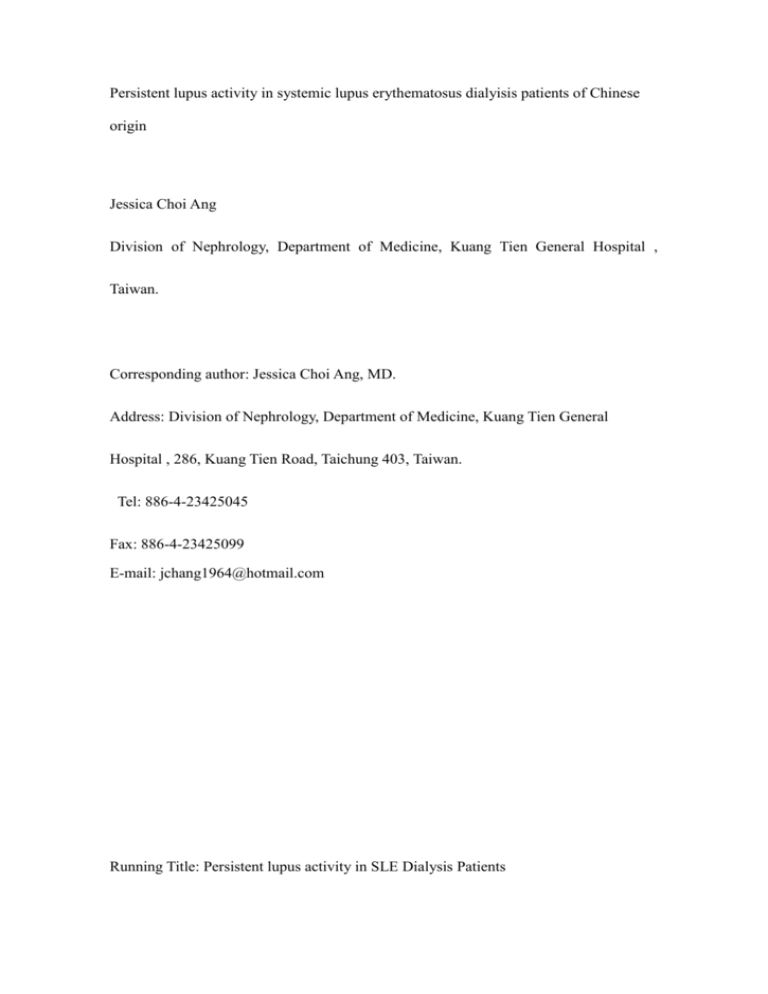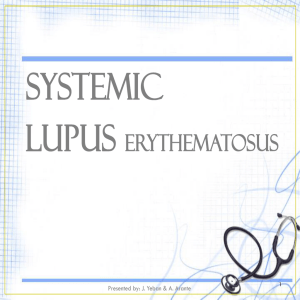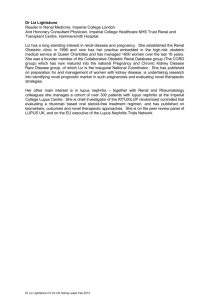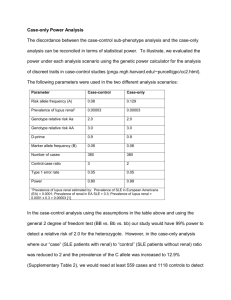persistent_SLE_in_ESRD
advertisement

Persistent lupus activity in systemic lupus erythematosus dialyisis patients of Chinese origin Jessica Choi Ang Division of Nephrology, Department of Medicine, Kuang Tien General Hospital , Taiwan. Corresponding author: Jessica Choi Ang, MD. Address: Division of Nephrology, Department of Medicine, Kuang Tien General Hospital , 286, Kuang Tien Road, Taichung 403, Taiwan. Tel: 886-4-23425045 Fax: 886-4-23425099 E-mail: jchang1964@hotmail.com Running Title: Persistent lupus activity in SLE Dialysis Patients Abstract Aims: To assess whether serological lupus activity is reduced in systemic lupus erythematosus(SLE) dialyisis patients of Chinese origin. Methods: This was a retrospective analysis of Chinese patients with SLE who are followed in a single hospital, Taiwan. The serological lupus activity of SLE were studied during end-stage renal disease(ESRD) before and after the institution of dialysis. Controls consisted of fifty-four age and sex matched patients in the clinic with lupus nephritis who had not developed renal insufficiency. We measured anti-nuclear antibody, serum complement 3 , and anti-double-stranded DNA levels. Patients were followed for at least 1 year after the institution of dialysis therapy or until their death. Results: We collected twenty-seven patients, 8 males and 19 females. The mean age was 36.1±2.3 years. Seven patients were undergoing peritoneal dialysis, the others hemodialysis. There was a significant decrease of serological lupus activity in ESRD with respect to controls. However, the serological lupus activity did not decrease significantly after dialysis. Five patients died during the followup period, most of them of sepsis. The mortality rate was 5/27( 18.5%) Conclusion: Chinese Patients with SLE who develop ESRD may exhibit a fall in serological lupus activity, although this continues after dialysis. Key Words: Systemic lupus erythematosus, end-stage renal diseases, dialysis, Lupus autoimmunity, Chinese Introduction Whether lupus activity decreases in lupus patients who reach end-stage renal disease (ESRD) has been investigated by many researchers.[1-10] Most reports suggested that the clinical activity of systemic lupus erythematousus (SLE) was quiescent in most patients with ERSD under regular dialysis.[1-7] However, there are different reports indicating that a moderate degree of extrarenal disease activity does persist in these patients. [8-11] The literature reports mainly Caucasians. Recently Krane et al [11] reported that SLE did not always burn out in patients who reached ESRD, although not all patients with SLE leading to ESRD continue to manifest active lupus. The data from their series of lupus patients who underwent dialysis suggested that black race was an important independent variable in the renal and overall prognosis of patients with lupus nephritis.[11] Besides, most studies assessed the lupus activity by the flare of clinical manifestations of SLE, although some clinical events could be misleading. For example, pericarditis or pleuritis may have occurred because of uremia or dialysis rather than the lupus flares. Fever could have been erroneously attributed to lupus rather than infection. On the contrary, serological data such as level of anti-nuclear antibody(ANA), serum complement 3 (C3 ), and anti-double-stranded DNA (anti-dsDNA) may provide better evidence of lupus activity in these patients. In order to evaluate the possibility that there might be a subgroup of patients in whom SLE does not burn out when they develop ESRD, a single center without the confounding effects of racial diversity is necessary. Therefore, a retrospective study to evaluate the serological lupus activity before and after the dialysis in Chinese end-stage lupus nephritis patients was performed. Patients and Methods Patients selection The medical records of all patients with SLE and ESRD who received Dialysis (defined as Group I) at Veteran General Hospital, Kaohsiung, Taiwan, from Oct 1, 1990 to Sep. 30 2001, were selected by a computer base registration system. The lupus nephritis controls (Group II) were selected as the age and sex matched patients in the clinic with a history of lupus nephritis who had not developed renal insufficiency. In these control , lupus nephritis had been documented by renal biopsy. Thorough review of medical records was undertaken in each patient. Twenty-seven patients, all of whom met at least four criteria of the American Rheumatism Association for SLE [12], form the cohort of this report. All patients of this study had been receiving dialysis for at least six months. Methods of assessment The demographic data including sex, age at the time of study, age at the time of SLE diagnosis and ESRD was collected by chart review. The evidence of laboratory markers of lupus activity included levels of ANA, serum C3 , and anti-dsDNA before the institution of dialysis therapy. The serum C3 were checked by nephelometry (Dade Behring, Marburg, Germany). The anti-dsDNA antibodies were detected by enzyme-linked immunosorbent assay. Hypocomplementemia was defined as serum C3 lower than 72 µg/dL The serological lupus activity was also assessed over a 3-month period after the institution of dialysis. Patients were followed for at least 1 year after the institution of dialysis therapy or until their death. Fifty four lupus nephritis patients were selected as controls and assessed in the same way ( serological lupus activity). Statistical analysis To detect any difference in baseline characteristics between those ESRD patients before dialysis and those without renal insufficiency (lupus nephritis controls), Fisher’s exact test was used for categorical variables, while the nonparametric Mann-Whitney test was used for continuous variables. The paired and unpaired Student’s t-test were used to compare paired data and between groups, respectively. All numerical variables were expressed as meanone standard deviation(SD). A P-value of less than 0.05 was considered statistically significant. Analysis was performed using SPSS software. Results There were twenty-seven patients with SLE and ESRD, 8 males and19 females. (Group I, n=27). Seven patients were undergoing peritoneal dialysis, the other patients were undergoing hemodialysis. Fifty four lupus nephritis patients without renal insufficiency were selected as controls (Group II, n=54). Pertinent demographic data are listed in Table 1. There were no significant differences between groups concerning sex, age at the time SLE diagnosis and at the time of study, and duration of disease. An average time of 6 years elapsed from the diagnosis of lupus nephritis and the development of ERSD. These patients had a mean age of 31 years when dialysis was initiated, and they were studied, on average, two years later. The serological lupus activity between SLE in ESRD patients and lupus nephritis controls are shown in table 2. There was a significant decrease of serological lupus activity in ESRD as compared to controls. The serological lupus activity in the period before and after the institution of dialysis therapy are shown in table 3. Serological lupus activity continued in the majority of patients. There was no significant difference in serum C3 level or anti-dsDNA titer before and after dialysis. Five out of twenty-seven patients with SLE in ESRD died during the Follow-up period, one male and four females. Their age ranged from 19 to 42 years. The duration of dialysis ranged from 12 months to 8 years. The serological lupus activity was elevated. Four of them died of sepsis, one died of a cardiovascular event. The mortality rate was 5/27( 18.5%) Discussion ESRD is a major contributing factor to morbidity and mortality in patients with SLE. As dialysis therapy became routine for all patients with ESRD, their survival improved significantly. With prolonged survival, it was observed that lupus activity decreased despite reduced immunosuppressive treatment. Fries et al [1] were the first to call attention on the effects of ESRD on the clinical course of SLE. A comparison of early (near-normal renal function with lupus nephritis) and late (initiation of dialysis therapy) specific lupus symptoms in 13 SLE patients revealed marked clinical and serological improvement, such that the diagnosis of SLE could not be made, at the time of dialysis, without knowing prior history. Since that time, there have been authors reporting minimal lupus activity in SLE patients undergoing chronic dialysis. [2-7] Jarrett et al[2] reported minimal lupus activity in their 14 patients undergoing hemodialysis, most of whom had reduced lupus activity after beginning dialysis. Five-year survival, however, was lower in their lupus patients compared with the general dialysis population, and this was attributed to infectious and vascular-access complications. However, there are conflicting reports demonstrating that a moderate degree of extrarenal disease activity does persist [9-10]. Nossent et al [10] reported, from the Dutch SLE Registry, the Dutch experience with 55 patients treated with either hemodialysis or peritoneal dialysis. Both the need for immunosuppression and overall extrarenal disease activity were reduced, but not abolished, after initiation of dialysis. The hypothesis of there may be a subgroup of patients in whom SLE does not burn out when they develop ESRD prompted our study. This study has several unique reasons. First, most studies assessed the lupus activity by the flare up of clinical manifestations of SLE. There might be some potential bias when ambiguous clinical events are considered, like pericarditis or pleuritis, which might have occurred because of uremia or dialysis. There have been no prospective studies performed to our knowledge. Since serological markers represent a more objective measurement of disease activity, it seems logical to use lupus serological data such as level of anti-nuclear antibody (ANA), serum complement 3 (C3 ), and anti-double-stranded DNA (anti-dsDNA) as unequivocal evidence of lupus activity. Secondly, the most previous literatures described mainly Caucasian people. Some researchers proposed there may be a subgroup of patients in whom SLE does not burn out when they develop ESRD. Is it the racial factors that makes the different prognosis in patients with lupus nephritis? Krane et al [11] reported that black race was an important independent variable in the renal and overall prognosis of patients with lupus nephritis. The data from their series of lupus patients who underwent dialysis suggested that that lupus activity may persist in patients with ESRD. It is speculated that the study population, 84% of whom were black women, may represent a subgroup of patients with lupus in whom the disease remains active, even after they have developed ESRD. The patients in this study were all Chinese and received regular follow-up at a single center. Though it is a retrospective study, it can still highlight the serological lupus activity before and after the dialysis in Chinese end-stage lupus nephritis patients. Last, our study showed that the major cause of mortality in patients with SLE and ESRD was represented by infectious complications. Moreover, the serological lupus activity were high and four of them died of sepsis. Since none of the four patients had received high-potency cytotoxic drugs or high dose corticosteroid therapy, it is unlikely that the immunosuppressive therapy predisposed them to serious infection. From the standpoint of persistent low serum complement level, one might consider the possibility of immunological trigger activity or exhaustion, that requires further studies. The limitation of this study included the method of retrospective study, the abscence of the concomitant clinical activity index, and the small sample size. It would be ideal to include more patients in a prospective cohort study and correlate simultaneous symptoms with serological study. More study about the pathogenesis of different serological and/or clinical lupus activity among different subgroup of SLE patients are also needed in the future. In summary, the precise relationship between ESRD and SLE activity remains incompletely understood, although it is expected that most Western patients with advancing renal disease may experience a significant decline in SLE activity. Chinese patients with SLE who develop ESRD continue to display evidence of serological lupus activity after dialysis, although some degree of reduction is demonstrable. Such patients require careful long term followup to prevent the possibility of sepsis. References 1. Fries JF, Powers R, Kempson RL. Late-stage lupus nephropathy. J Rheumatol. 1974;1:166-175. 2. Brown CD, Rao TKS, Maxey RW, et al. Regression of clinical and immunological expression of systemic lupus erythematosus (SLE) consequent to development of uremia. Kidney Int. 1979;16:884.. 3. Jarrett MP, Santhanam S, Del Greco F. The clinical course of end-stage renal disease in systemic lupus erythematosus. Arch Intern Med. 1983;143:1353-1356. 4. Coplon NS, Diskin CJ, Petersen J, Swenson RS. The long-term clinical course of systemic lupus erythematosus in end-stage renal disease. New Engl J Med. 1983;308:186-190. 5. Cheigh JS, Stenzel KH, Rubin AL, et al. Systemic lupus erythematosus in patients with chronic renal failure. Am J Med. 1983;75:602-606. 6. Pahl MV, Vaziri ND. Maintenance hemodialysis in end-stage lupus nephritis. Int J Artif Organs. 1984;7:243-244. 7. Cheigh JS, Kim H, Stenzel KH, et al. Systemic lupus erythematosus in patients with end-stage renal disease: long-term follow-up on the prognosis of patients and the evolution of lupus activity. Am J Kidney Dis. 1990;16:189-195. 8. Wu GG, Gelbart DR, Hasbargen JA, Inman R, McNamee P, Oreopoulos DG. Reactivation of systemic lupus in three patients undergoing CAPD. Perit Dial Bull. 1986;6:6-9. 9. Rodby RA, Korbet SM, Lewis EJ. Persistence of clinical and serological activity in patients with systemic lupus erythematosus undergoing peritoneal dialysis. Am J Med. 1987;83:613-618. 10. Nossent HC, Swawak TJG, Berden JHM. Systemic lupus erythematosus: analysis of disease activity in 55 patients with end-stage renal failure treated with hemodialysis or continuous ambulatory peritoneal dialysis. Am J Med. 1990;89:169-174 11. Krane NK, Burjak K, Archie M, Odonovan R. Persistent lupus activity in end-stage renal disease. Am J Kidney Dis. 1999;33:872-9. 12. Tan EM, Cohen AS, Fries JF. The 1982 revised criteria for the classification of systemic lupus erythematosus. Arthritis Rheum1982; 25:1271-1277. Table 1. Demographic details of SLE on chronic dialysis patients and lupus nephritis controls Group I(n=27) Age at the time of SLE 26.1±2.2 Group II(n=54) p 25.4 2.2 NS 35.4 2.3 N diagnosis (years) Age at the time of study 36.1±2.3 (years) Male: Female 8:19 16: 38 NS Disease duration(years) 8.2±2.2 7.8 2.2.5 NS Age at diagnosis of ESRD 30.8±2.2 Group I: SLE with end-stage renal disease patients Group II: lupus nephritis controls with a history of lupus nephritis who had not developed renal insufficiency. Data are expressed as mean one SD. SLE:systemic lupus erythematousus NS = no statistical significance. Table 2. Serological lupus activity between SLE in ESRD patients and lupus nephritis controls Serological lupus Lupus nephritis controls SLE in ESRD patients activity (n=54) (n=27) Positive ANA 100% 77.8%* Mean ANA titer 333 172 Decreased serum C3 100% 37.0* Elevated anti-ds DNA 100% 29.6* level SLE= systemic lupus erythematousus, ESRD = end-stage renal disease ANA= anti-nuclear antibody, anti-dsDNA = anti-double-stranded DNA *P-value less than 0.05 Table 3. Serological lupus activity before and after dialysis in 27 SLE patients on chronic dialysis Serological lupus activity Before dialysis After dialysis Positive ANA 77.8% 74.1% Mean ANA titer 172 160 Decreased serum C3 37.0 40.7 29.6 26.0 level Elevated anti-ds DNA SLE= systemic lupus erythematousus, ANA= anti-nuclear antibody, anti-dsDNA = anti-double-stranded DNA








